Popular words in Málaga, Spain
Monday, April 29, 2013
In Málaga, a nice city in the South-east of Spain, there are still several expressions, based on several words used in the past.
For example, one funny expression is “Estar Aliquindoi (or Alikindoi)”, that means “To be attentive”.It comes from the English expression “Look and do it”.It is said that the English expression started to be used, when the first English people came to Málaga, through the port; but it was changed with the popular way of speaking in the Andalussian language.
Another expression, that I find curious, that is known, in Málaga, since the beginning of the last 20th century, is “Canequi” or “Darse un canequi”.
As another words, “Canequi” was a word originating in the port of Málaga. This port has been through its history the main entrance to the city. Through it came bad and good things, currencies. One of the visitors were those “Bocoyes” (Casks) and “Toneles” (Barrels) of wine, which largely departed from the port to distant lands, but they also came from many parts of the world.
Our port was seen on many occasions invaded by large containers carrying Cuban rum. According feature there were two models of containers: some similar to the barrels and other thin ceramic with a capacity of 26 or 34 pounds, besides ceramic bottles. These large and heavy containers was given the name of "Canéis". The transport from the port to the carts that had to move this precious nectar to taverns or ethyl main wineries of our city, it was hard and heavy, plus fragile, so some trucks were available with rubber wheels instead of iron, carrying the "Canéis" to the main wagon, which was pulled by nags accustomed to working hard and heavy to haul barrels to wineries.
In those carts, pulled by hard men, are carefully placed those large containers, called Caneis. The children of the last century wanted to play, like those of any age, and began to climb on trucks and take a fun ride, next to that rum come from Cuba or Jamaica. The children knew that those containers were called Caneis, but for them it was easier to say “Canequi”, then began to ask the workers of the port to let them take a Canequi in the cart, that is a walk. From here, that word became so popular that it was used for any kind of ride; so much so, that we could hear as such other person was invited to take a "canequi" by the Lighthouse or in the field, etc.
Till soon, kind regards,
Luis.
Sponsored by Costaluz Lawyers.
Please click down here:
.jpg)
 0
Like
Published at 1:19 AM Comments (0)
0
Like
Published at 1:19 AM Comments (0)
Old words in Spain
Friday, April 19, 2013
Old words may be also named “Palabras viejunas” (“Viejunas words”). Most of these words have disappeared from the Spanish, but were used extensively in classical literature, such as books of Cervantes.
Between other words, we find: “Olgura” (it meant “Party”, “juerga” = “bringe”, “amusement between many people”).
There was an expression: “A boca de sorna” (literally: “A mouth of sarcasm”).It is refered to the moment when the light of day is gone –when night is coming--.”Sornar” means “Sleep” and “Sornar” comes from the latin “Surnia”, that means: “Mochuelo” (“Owl”), who is the “Ave nocturna” (“Night owl”).Then, the moment, when owl goes out and it is the moment to sleep, is baned “A boca de sorna”.
Anyway, many words, between all of them, are still used by old people, in some villages of Spain.
Another old expression is: “A campana herida” (“To a bell wound”).But it was used another similar expression: “A campana tañida”. Both cases meat: “When people were called, cause something important, they were called “A campana”, “with the sound of a bell”. People were warned when there was danger.
Other word is: “Amancebado”.It comes from “Amancebamiento”, that means: “The sexual treatment anong a man and a woman, who are not married among them”.
Another word is: “Virote”, that is refered to a “Boy single, idle and precious handsome”.
In Extremadura (almost south of Spain) it was used the word “Cancamurria”, that meant: “Melancholy” –in Galice (Nort-west of Spain) is still used “Morriña”--. Talking about “Morriña”, here you can watch a video of the song “Un canto a Galicia” (“A song to Galicia”), by Julio Iglesias:
Song: "Un canto a Galicia", by Julio Iglesias.
And this is the lyrics of this song:
Eu queroche tanto,
e ainda non o sabes...
Eu queroche tanto,
terra do meu pai.
Quero as tuas ribeiras
que me fan lembrare
os teus ollos tristes
que me fan chorare.
Un canto a Galicia, hey,
terra do meu pai.
Un canto a Galicia, hey,
miña terra nai.
Teño morriña, hey,
teño saudade,
porque estou lonxe
de eses teus lares.
Eu queroche tanto,
e ainda non o sabes...
Eu queroche tanto,
terra do meu pai.
Quero as tuas ribeiras
que me fan lembrare
os teus ollos tristes
que me fan chorare.
Un canto a Galicia, hey,
terra do meu pai.
Un canto a Galicia, hey,
miña terra nai.
Teño morriña, hey,
teño saudade,
porque estou lonxe
de eses teus lares.
Teño morriña,
teño saudade,
porque estou lonxe
de eses teus lares...
De eses teus lares...
De esos teus lares...
¡Teño morriña!
¡Teño saudade!
Un canto a Galicia, hey,
terra do meu pai.
Un canto a Galicia, hey,
miña terra nai.
Teño morriña, hey,
teño saudade,
porque estou lonxe
de eses teus lares.
Un canto a Galicia, hey,
terra do meu pai.
Un canto a Galicia, hey,
miña terra nai.
Teño morriña, hey,
teño saudade,
porque estou lonxe
de eses teus lares.
Teño morriña, hey,
teño saudade,
porque estou lonxe
de eses teus lares.
Teño morriña, hey,
teño saudade,
porque estou lonxe
de eses teus lares.
Another old word was: “Churrullero”, that means: “Charlatán” (“Chatterbox”), someone who talks too much.
There was another word, very used, named: “Engarabulloso”, that means: “Someone who lies, who cheats”.
Another word is: “Cañuto”, that means: “Someone, who betrays you, accuses you”.
Other old word: “Abigeo”, that means: “A rustler”.
An another one: “Matungo" , that means: “Old horse”.
Another one: “Acerico”, that means: “Where you prick pins”.
Another old word: “Caramillo”.I was a musical instrument, concretely: a flute made of cane.
Another expression was: “To sing for the pad”. It is refered to sing without instrument and just for distraction. It happened when someone, who sang very well, was asked to sing something, but it, by humility, said it only sang “for its pad”.
I hope that you have enjoyied with this post.
Till soon, kind regards,
Luis.
Sponsored by Costaluz Lawyers.
Please click down here:
.jpg)
 0
Like
Published at 9:28 PM Comments (0)
0
Like
Published at 9:28 PM Comments (0)
Book in Spain
Friday, April 19, 2013
On the occasion of the celebration of the Day of the Book, the next April-23, Mª Teresa Lizaranzu, General Director of Policy and Cultural Industries and Book and President of the Commission on Intellectual Property , has been interviewed on radio in the Reader's House in Madrid.
She says that the publishing industry has suffered a transformation, cause of two reasons: the crisis that affects this and to other sectors and the second reason is the digital challenge. She hopes that the different companies of book are abble to be adapted to the new situation, because the publishing industry is the main sector in the Culture of Spain.
The interview to Maria Teresa was celebrated in the Reader´s House, in Madrid.
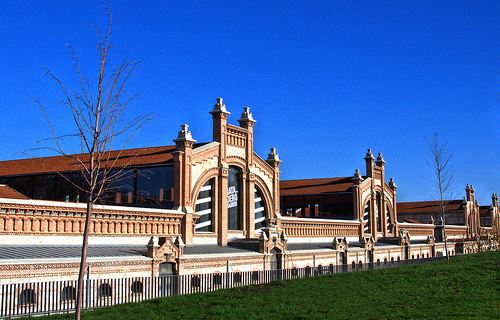
"MATADERO MADRID RIO 074", Madrid, Spain, by druidabruxux, at flickr.com
She knows that the booksellers in Spain are worried, cause of this crisis (economic crisis andcrisis in the reading of books of paper); but she is optimistic, because she thinks that booksellers will be abble to adapt themselves. She says that in Spain there is one bookshop for 15.000 people.
Spain is the first country in production of books in Spanish, but Maria Teresa says that Spain is also one of the major powers in publishing. She says that the production is very good in Spain.
She also thinks that is important to know that tax book, in Spain, is less than in other countries.In Spain, it is: 4%; but in France is: 6%, in Germany is: 7% and in Denmark is: 25%.
The book industry needs to find a new business model to cope with strong competition from new technologies.
She also says that the reading habit (only of book), in Spain, is around 63%.
I hope that you liked this post.
Till soon, kind regards,
Luis.
Sponsored by Costaluz Lawyers.
Please click down here:
.jpg)
 0
Like
Published at 12:45 AM Comments (1)
0
Like
Published at 12:45 AM Comments (1)
More funny phrases by spanish children 4
Thursday, April 18, 2013
Nacho, 6 años:
Una noche, antes de acostarse, Nacho le preguntó a su madre:: “Mamá, ¿Quién es Malamén?”. “No lo sé, hijo, no tengo ni idea, si no me dices algo más….”, le contestó ella. Nacho se quedó pensando un momento y, al final, concluyó: “Mira, mamá, yo creo que es alguien malísimo, porque siempre que rezamos en el cole, decimos: “…y libranos del Malamén”.
Nacho, 6 years old:
One night, before bed, Nacho asked his mother: "Mom, who is Malamén?". "Do not know, son, I have no idea, unless you tell me something more ...." she replied. Nacho thought for a moment and finally he said: "Look, Mom, I think that is one lousy, because whenever we pray in school, we say:" ... deliver us from Malamén ".
Lyre, 3 años:
Su madre le preguntó: “Leyre, ¿Qué quieres comer hoy: pollo o albóndigas?”. “Almóndigas, mamá”, respondió Leyre. Su madre le corrigió: “Cariño, albóndigas, con b”. Y Leyre le respondió: “No, mamá, almóndigas con tomate”.
Leyre, 3 years old:
Her mother asked:"Leyre, what you want to eat today: chicken or meatballs? ". "Meatballs, Mom," said Leyre. Her mother corrected her: "Honey, meatballs, with b". And Leyre replied: "No, mom, meatballs with tomato".
Odei, 6 años:
Odei estaba constipado y su madre le puso un supositorio, por primera vez en su vida. A las 8 horas, su madre fue a ponerle otro supositorio y Odei, todo agobiado, dijo: “Pero primero me sacas el que me has puesto antes, ¿No?”.
Odei, 6 years old:
Odei was constipated and his mother put a suppository, for the first time in his life. At 8 hours, his mother went to put another suppository and Odei, all overwhelmed, said: "But first you get me where I have put before you, right?".
Lucía, 2 años:
Cuando su madre fue a recogerla, a su primera clase de natación, Lucía salía muy contenta, en brazos de su profesor, y la madre le preguntó a la niña: “¿Qué tal?, ¿Te ha gustado?. “Sí, es muy guapo”, contestó Lucía.
Lucía, 2 years old: When her mother came to get her, to her first swimming lesson, Lucy ran very happy to the arms of his teacher, and the mother asked the girl: " What?, What do you think?”. "Yes, he's very handsome," said Lucia.
Paula, 6 años:
La noche despues de una visita a Faunia, cuando se iba a dormir, su madre le dijo: “Que sueñes con los angelitos”. Y Paula contestó: “Sinceramente, mamá, prefiero soñar con los pingüinos”.
Paula, 6 years old:
The night after a visit to Faunia, when she went to sleep, her mother said, "That Sweet dreams." And Paula said: "Honestly, Mom, I prefer to dream of the Penguins"."When the mother says: “That sweet dreams”, we use to say: “That you dream with little Angels”.
Angela, 4 años:
“¡Mamá, mama!, ¿Sabes qué hemos hecho hoy en el cole?”."Dime, hija”, le dijo su madre."Hemos fumado”, le respondió Ángela. “Pero, hija, eso no puede ser, no se fuma; ni siquiera se juega a fumar.Ya hablaré yo con la profesora para ver qué juego es ese”, le dijo, un poco enfadada. “Mamá, fumando, no, ¡fu-man-do!, haciendo cosas difíciles con los números!”.
Angela, 4 years old:
"Mom, mom!, You know what we did today at school?". "Tell me, daughter," said her mother. "We smoked" Angela replied. "But, daughter, this can not be, do not smoke, do not even play to smoke. I will already talk to the teacher to see what game is this", she said, a little angry.
Of course, Angela meant: Su-man-do = to add a number to another one.
Nerea, 5 años:
Nerea le comentó a su madre: “Mamá, ayer vi a dos gemelos; uno de seis y otro de cuatro años".Su madre, extrañada, le preguntó: “¿Y por qué dices que eran gemelos?”. Nerea le contestó: “Porque iban vestidos iguales”.
Nerea, 5 years old:
Nerea told her mother: "Mom, yesterday I saw two twins, a six and a four years old". Her mother, surprised, asked: "Why do you say they were twins? ". Nerea replied: "Because they were dressed the same".
You can find these funny sentences and other similar, in the new book, named: “Nuevas frases célebres de niños”.
I hope that you have enjoyied yourself.
Till soon, kind regards,
Luis.
Sponsored by Costaluz Lawyers.
Please click down here:
.jpg)
 0
Like
Published at 12:28 AM Comments (0)
0
Like
Published at 12:28 AM Comments (0)
The little-known art of the Spanish artist Angel Garó
Tuesday, April 16, 2013
Angel Garó is a humourist, who triumphed in the 90s, thanks to his cooperation in the program-contest of the Spanish Television: "1,2,3 ... responda otra vez" (“1,2,3,…..answer again” (1992).Here, you can watch a video of a show by Angel, playing two of his characters: Pepe Itarburi and Juan de la Cosa. The style of Ángel, trough his characters, is to use the absurd: he is going to tell stories, with sentences without sense. Also he tends to play dumb; for example, Juan de la Cosa wants to the public of the contest –and also people at home— guess some riddles; but he is wrong to explain the riddles and find the result; for example, at the beginning, he says: “Una señora, bien señoreada, siempre está en la boca y siempre está mojada…, ¿Qué parte de la boca…la lengua….?...ya te lo he dicho” (“A lady, well señoreada --as well lady…great lady….more or less…--, she is always in the mouth and always wet….What part of the mouth….the tongue…?..like I said to you”).
Angel acted, on that show, during several weeks; but, after that, we never saw him again.He has been “missing”, for many years and, some days ago, I could listen to him on the radio, talking about his new projects.I think that he was not understood by people, in the 90s.Now he trys to show us his art through some new projects.
I did not know that he was as good artist…..I did not know that, for example, he is a great Art collector.Apparently, he is going to exhibit around 300 works –by Dalí, Picasso, Alberti, Julio Romero de Torres…and others.--, in a Gallery of Estepona (Málaga, South-east of Spain).
But Angel also participated in other projects, like a song by the Spanish group “SON DE SOL”.
Angel is an Actor, a Humourist, a Singer, a Bender….
He comes from Andalussia, because he was born in La Linea de la Concepción (Cádiz), just beside Gibraltar.
Before working in the program “1,2,3….”, Ángel was known throught the radio, in 1990.
Between other projects, now Angel is in Seville, because he is working in a Zarzuela, named “Entre Sevilla y Triana” (“Among Seville and Triana”).This is a Zarzuela, by the master Pablo Sorozábal. This work has been represented, in the theatre of La Maestranza, in Seville, the last days : 13, 14 and 15 of March. Angel has acted, in this Zarzuela, with one of the leading roles. This work premiered at the Teatro Arriaga, in Bilbao (North of Spain) and will be showed in Madrid very soon.
Angel is also bender movie; for example, he doubled to 32 characters, in the film: “Ferngully, the adventures of Zack and Crysta”, by the company Twenty Century Fox, and he got to enter in the “Record Guiness”.
But Angel also doubled the voice of the protagonist of the film “El jardin mágico de Stanley” (“The Stanley´s magic garden”), where Angel doubled the Stanley´s voice. This film was produced by the Company Warner.
The last film doubled by Ángel is “El Emperador y sus locuras” (“The Emperor's New Groove”), produced by Walt Disney. Angel acted as the Emperor Cuzco.
Angel loves to turn cartoon characters.He was asked to play Robin Williams; but he did not wanted to do that.
But Angel has another project, that he wanted to start many years ago, however he had no time for doing it.This project consists in provide some interpretation workshops. He wanted to begin them in Fuengirola and Estepona (Málaga, South-east of Spain), this month of April. In Fuengirola, in the first half of April and, in Estepona, in the second half of April.
Angel talks about the advantages of one-man show (in English named “Showman”). The public can get to know you, because they see you in multiple records. He says that is hard but also gratifying, because so the public can know all your capacities. He says that today are used works with few characters.
Well.I hope that you have enjoyied with this post about Ángel Garó.
Till soon, kind regards,
Luis.
Sponsored by Costaluz Lawyers.
Please click down here:
.jpg)
 0
Like
Published at 1:39 AM Comments (0)
0
Like
Published at 1:39 AM Comments (0)
The Pasodoble in Spain
Sunday, April 14, 2013
The Pasodoble or double step-up is a light march , used in military parades, adopted as a regulatory step two of Infantry, with a special feature that makes the troops can keep up regular: 120 steps per minute. The music that accompanies this march has duple and moderate movement was introduced in bullfighting. Also called the dance pasodoble running to the beat of the music.
Apparently the pasodoble comes from tonadilla, that was a composition in the first half of the eighteenth century served as conclusion of appetizers and stage dances and then from the middle of the century, it was used as a musical interlude between acts of comedies.
Today the major focus of pasodobles production focuses on the Spanish east, around the festival of Moors and Christians.
It is known as the “Pasodoble” dance originated in Spain around 1533 and 1538. Used in various regions for the event, is also one of the few couple dances that continue unabated today, is present in many parties (popular festivals) and still part of the tradition of all the regions of Spain . "At the beginning of the century, it was associated with “garroting”, a partner dance gypsy, quite alive and repetitive". It is also believed that this dance may have originated in France, where it was called pas-redouble, touched by military marching bands since 1780. Since this country was developing and spreading to other areas as a quick start regulating Infantry soldiers passing.
The “Pasodoble” is a very simple dance, with figures very free, so it is quite easy to learn. The position of the pair is equal to that of all the ballroom dances, facing each other and with the bodies stuck slightly displaced to the left. Its basic rhythm is very simple: one step time and must remain at all times with the bodies in parallel and with the left hand and right of men and women, respectively, joined. The “Pasodoble” is part of the repertoire of Spanish bands and usually consists of introduction and two main parts, with a rate with influence from the Flamenco. As dance is like a one-step, it differs in the number of steps you take to the dance and in their respective names.
Clase de Pasodoble en "Sin ir mas lejos".Parte 4.Music from "La Campanera"("The woman bell ringer").
Diana Navarro - Campanera (Woman bell ringer)
This is the lyrics of this song (this Pasodoble):
Por qué has pintao en tus ojeras,
la flor de lirio real.
Por qué te has puesto de cera,
¡Ay campanera!, por qué será.
Mira que to'el que no sabe,
cuál es la llave de la verdad
dice que no eres buena,
y a la azucena te pudieran comparar.
Dile que pare esa noria,
que va roando, pregonando lo que quiere.
Que por saberla tu historia,
le están buscando cómo y cuándo donde hiere.
¡Ay, campanera!, aunque la gente no quiera.
Tú eres la mejor de las mujeres
porque te hizo Dios, su pregonera.
Por qué se para la gente,
ná más la ven de pasar.
Porque es alondra valiente,
que alza la frente y echa a cantar.
Dicen que si un perseguío,
que anda escondío la viene a ver.
Cuentan que amante espera
la campanera con la ronda de las tres.
Ya era corona de gloria,
pa'aquel revuelo del desvelo por amores,
cuando el rodar de la noria,
tapó con velo to'aquel cielo de colores.
¡Ay, campanera!, aunque la gente no quiera.
Tú eres la mejor de las mujeres
porque te hizo Dios, su pregonera.
¡Ay, campanera!, desde el amante que espera,
con la bendición de los altares,
como manda Dios, su compañera.
These are the most known pasodobles:
Bullfighting: “Suspiros de España”, “España cañçi”, “La Gracia de Dios”, “El Gato Montés”, “Tercio de Quites”, “Pan y toros”, “Cielo andaluz”, “La Morena de mi copla”, “Francisco Alegre”, “Amparito Roca”, “El Beso”, “Plaza de las Ventas”, “Xabia o Pepita Greus”.
Militaries: “Soldadito español”, “El Abanico”, “Los Nardos”, “Las Corsarias”, “San Marcial o Los Voluntarios”.
Popular: “La Entrada”, “Islas Canarias”, “En er Mundo”, “Costa Dorada”, “Brisas de Malaga”, “Valencia”, “Mi jaca”, “La Campanera”.
Band: “Paquito el chocolatero”, “Fiesta en Benidorm”, “Petrel Pasodoble”, “Alegría Agostense”, “Educandos de Benejúzar”, “Pepe Antón”.
I hope that you have enjoyied yourself with this post.But…it should better if you came to Spain to dance any of our pasodobles.
Till soon, kind regards,
Luis.
Sponsored by Costaluz Lawyers.
Please click down here:
.jpg)
 0
Like
Published at 1:23 AM Comments (0)
0
Like
Published at 1:23 AM Comments (0)
Fruits and human body in Spain
Friday, April 12, 2013
Other parts of the human body have to do with fruits.At least, all of them have a similar origin.
For example, the word Amigdala comes from the word lmond), because this last one was used in the old Greece. In Greece it was used the word Almendra (Amygdala, that meant: bitter almond). It is true that the amigdala has a similar form than the almond
"Almendras", by Atzimba, at flickr.com
Another word is Manzana (Apple), that in Catalán is: “Poma” and in French is “Pomme”. And from there comes the word “Pómulo” (that is one of the two parts in a human face, down the eyes and beside the noise, that has a similar form that the fruit “Manzana” (“Apple”); in Latin the little apple was said: “Pomum”).
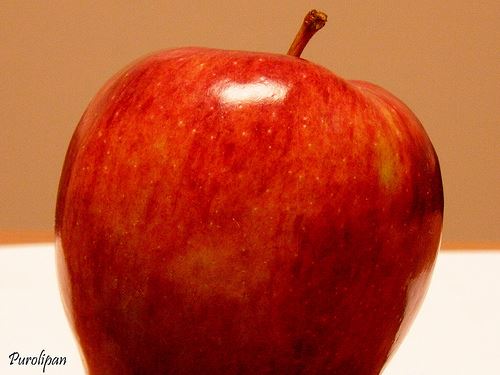
"Manzana III", by purolipan, at flickr.com
Other word is Higado “Liver”, that has to do with “Higo” (“Fig”), because, many centuries ago, cookers in Rome liked to fatten geese with figs, because, after that, they could cook a more palatable liver.In Latin, “Liver” was said: “Ficatum” and from it came: “Ficus” , that was “Fig” (higo).People in Rome loves such as the liver flavored fig, that they had a dish named “Yecur ficatum”, that meant: “Liver with figs”. Then, in Spanish, we use only “Higado” (“Liver”).
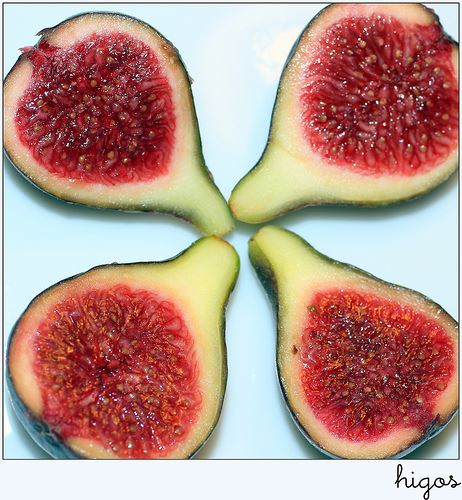
"higos", by M. Martin Vicente, at flickr.com
The word “Corazón” (“Heart”) has the same root in the Indo-European language: “Kerd” and from it comes “Heart” (in English), Kardia (in Greek); but it comes from the Latin: "Cor", cordis. Heart is formed by two ears and two wombs; this is the explanation: in our heart we have two “Auriculos” and two “Ventricles”. “Auriculo” should be the diminutive of “Ear” and the “Ventricle” should be the diminutive of “Womb”.

"Corazon Congelado", by laradanielle, at flickr.com
Another word is “Lips”, related with the strawberry, surely cause of the red color.

"Labios: Abismo de abismos", by Carlos Adampol, at flickr.com
Another important word is “Nuez” (“Walnut”), also named “The Adan walnut” –although it is cause of a mistake, because in Latin was used the phrase: “Pomum Adami” (literally: “Adán´s apple”.But also this phrase came from Hebrew “tappuach ha adam”, that means: “Protuberancia masculina” (“Male bulge”). The confusion is that in Hebrew, the word “Adam” means “Male” and the word to call “Bulge” is very similar than the word to call apple.
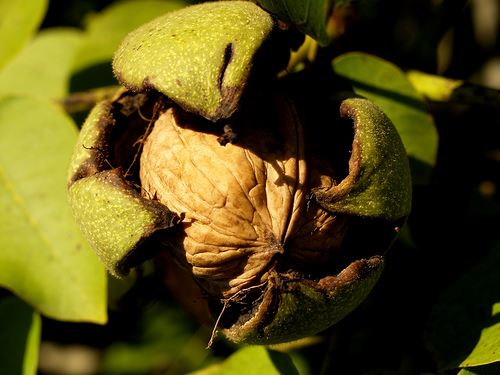
"Nou - Nuez (Juglans regia) 2", by fturmog, at flickr.com
I hope that you can find another words about this topic.
Till soon, kind regards,
Luis.
Sponsored by Costaluz Lawyers.
Please click down here:
.jpg)
 0
Like
Published at 7:08 PM Comments (0)
0
Like
Published at 7:08 PM Comments (0)
Municipalities in the province of Madrid, in Spain
Thursday, April 11, 2013
In the province of Madrid there are 178 municipalities. Well, but Felipe Alonso Fernandez-Checa talks about all of them in his new book: “Misterios, Anécdotas y leyendas de la Comunidad de Madrid” (“Mysteries, anecdotes and legends of the Community of Madrid”).
Felipe thins that the province of Madrid is wonderful, but a gret unknowed province.For example, he says that there are several and wonderful swamps; for example “The swamp of La Pinilla”).
Felipe says that one of the most rich municipalities cause of culture is Alcalá de Henares. Another one is El Escorial. But he says he likes much more the most “poor” municipalities (“poor” only in anecdotes, so they are less known); for example he talks about Ambite; this municipality is from Alcalá de Henares to Guadalajara. However, despite being little known, Ambite has three impressive legends –well….two legends and one anecdote--: one of the two legends says that in the Middle Ages, there was a couple in love; but he had to go to a war and she satyed crying. Then, someone, in the municipality told her to eat an acorn of an oak and if the acorn was sweet, he should go back with her; but, if the acorn was bitter, he would die in the war. Today some couples in love still go to the same oak, to eat a acorn and, if it sweet, they marry.
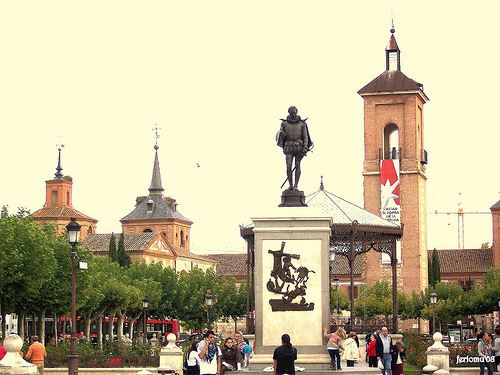
"Alcalá de Henares (Madrid) Cervantes (1600 x 1200)", Alcalá de Henares, North of Madrid, Spain, by ferlomu, at flickr.com
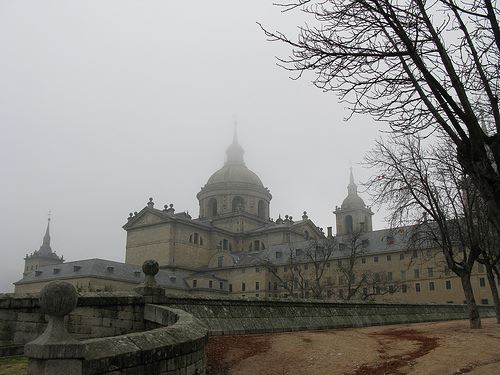
"El Escorial", San Lorenzo de El Escorial, Nort-west of Madrid, by aa440, at flickr.com
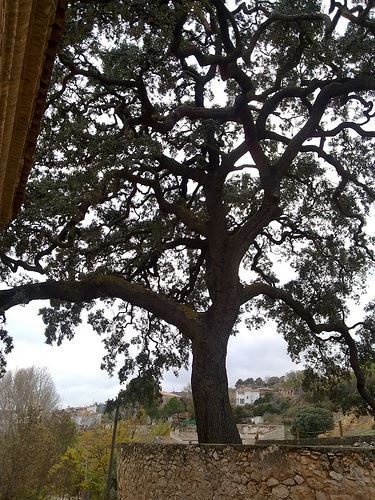
"Encina centenaria de Ambite (Madrid)", "Centenarial oak of Ambite (Madrid)"Ambite, North of Madrid, by Herbolario Allium, at flickr.com
Another legend says that in Ambite there was a house where lived a marriage.It said that he was a very good person and he help very much to poor people.But his wife was not as good person and she did not like that her husband helped to people, with money for example.Then, she killed her husband, buried him in the field and his body appeared when someone was doing a work. Then, the legend says that a day, a storm separated the house from the rest of the people.Here, you can see the house, beside the famous oak of Embite:
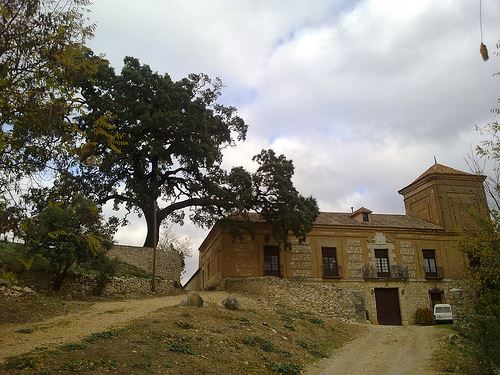
"Encina centenaria de Ambite (Madrid)".Here you can see the famouse house, just beside the famous oak. Ambite, North of Madrid, Spain, by Herbolario Allium, at flickr.com
The third anecdote is that in the entrance of the municipality of Ambite, there is a monument to Eyes; it is formed with two arches, with tiling, with a lot of famous phrases dedicated to the world of eyes, wrotten on the monument.
Another anecdote of Madrid is that in Majadahonda, appeared a whale.It is because the anagram of Left United ( a Spanish political party) is a whale.The explanation is that many years ago, a man drunk used to go drinking to a little lake and he threw the empty bottles to the little lake; but, one day he was almost slept and threw a bottle at it began to sink and this man screaming: “The whale, the whale, the whale….!!!!” And many people of the municuipality went there with sticks in order to kill “the whale”……..althought it was a bottle…... Also there were other packages of cavalry and people started to shoot them.
Well, but you can find other anecdotes like these in the Felipe´s book.I hope that you can read it.
Till soon, kind regards,
Luis.
Sponsored by Costaluz Lawyers.
Please click down here:
.jpg)
 0
Like
Published at 4:25 PM Comments (0)
0
Like
Published at 4:25 PM Comments (0)
The figure of father in Spain
Wednesday, April 10, 2013
Javier Urra (a Psychologist) says that in the past, the father figure was about a very serious sir; but, today, a father is closer to his son or daughter. He is usually more sensitive with them.
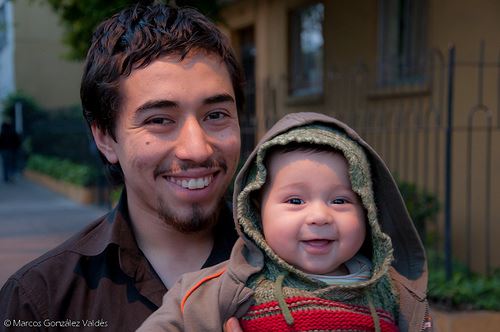
"Nico y Vicente", by Marcos S. Gonzalez Valdes, at flickr.com
The child usually inherit the qualities of his father. If the father is a good person, a righteous and worker person, the child will learn that behavior.
Another trouble, in the education of a child is that today, his or her father and/or mother go back home too late, because they usually work out of home; then today children are less time with their parents.
Other idea that Javier Urra says is that, “When there are several children, in a family, the father must to educate them with a different way, because he lovethem on the same way”.
I hope that education in Spain improve much.
Till soon, kind regards,
Luis.
Sponsored by Costaluz Lawyers.
Please clic down here:
.jpg)
 0
Like
Published at 6:57 PM Comments (0)
0
Like
Published at 6:57 PM Comments (0)
Professions rated in Spain
Tuesday, April 9, 2013
The Center of Researches Sociological (CIS) has made a survey, where there are questions like: “What do you think that the better and the worst professions are?”.
Well, there are different answers.
The most people said the the worst professions are Journalist and Judge.And, the best profession is Medical.
Surely, today the Journalism has less prestige, because it seems to search more business that to offer news. Anyway, although it is negative, it is better to have journalist, in favor to the Democracy.
Another reason that makes to Journalism to have less prestige is the crisis of the paper, cause of Internet.Journalism need to transform the format of the paper.
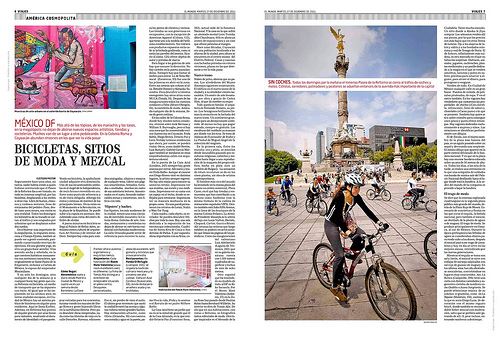
Mi foto "Angel" en El Mundo de España, by Javier Hidalgo, at flickr.com
Other profession with less lrestige is Judge. Today, the Judges have more independence; but, anyway , they still are under some influence of the political parties.
Another profession with less prestige is also the Banker.
However, another profession, that had less prestige, Farmer, today is more valued, because many people is going back to field, from city.
I hope that some things chage in Spain in favor of the most people.
Till soon, kind regards,
Luis.
Sponsored by Costaluz Lawyers.
Please click down here:
.jpg)
 0
Like
Published at 12:09 PM Comments (0)
0
Like
Published at 12:09 PM Comments (0)
The deeper source of Spain
Monday, April 8, 2013
In the Little villaje of the province of Soria (almost nrth of Spain), Muriel de la Fuente, there is a famous source (“La Fuentona de Muriel”). This is the deeper source in Spain; it means it is the deeper cave, that is cover with water (a flooded cave).
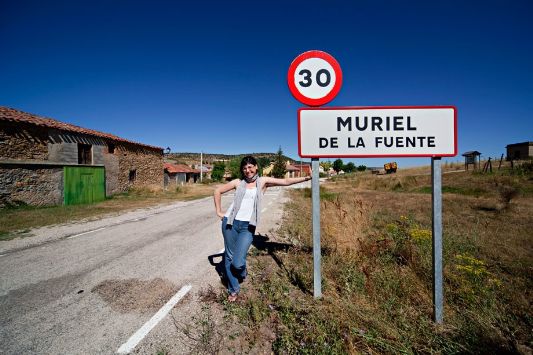
Muriel de la Fuente, Soria, North of Spain.
An special team of speleologists of Spanish Television, went to that cave, in 1977, as their first time.Now, in 2013, they have gone there again, with a better material (better buttles, with a mix of gases –concretely, more oxygen than nitrogen (this mix is named “.

"La Fuentona, outside the cave".
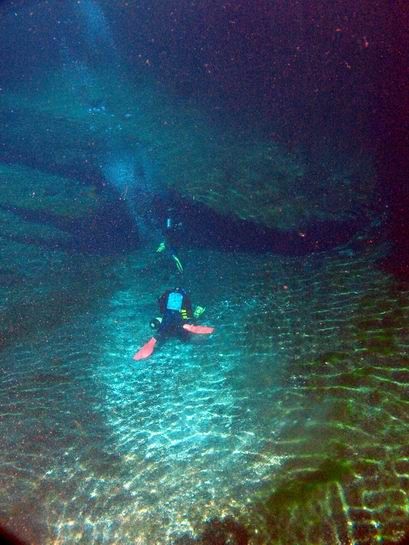
"Inside the cave La Fuentona".
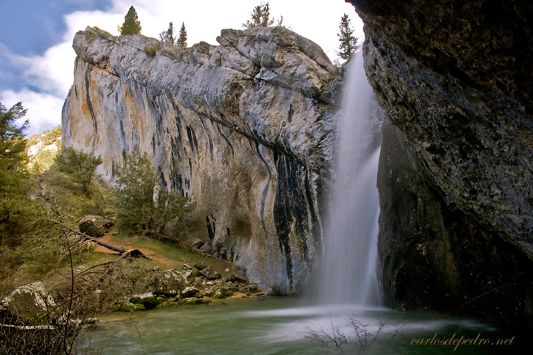
"The waterfall, outside the cave".
“La Fuentona” has been declared Nature Monument by the Junta de Castilla-León. It is located in the province of Soria, in the foothills of Pinar Cabrejas and 1 km from Muriel de la Fuente.
One of the members of the team of TVE (Spanish Television), Carmen Portilla, said the following: “This cavity occupies a special place in my life, not only for its beauty but mysterious because it has been linked to key moments in my personal life and my work as a speleologist-diver woman”.
Carmen also says that, when she was preparing the inmersion in the cave “La Fuentona”, at the end of the 70s, she received several diving courses, lasting several months.She and her companies prepared them, diving in other caves, like for example “El Pozo Azul” (“The Blue Well”) in Cavanera (Burgos, North of Spain).
She says she had to do a great effort to learn go down, in the caves; but when she saw the blue colour and the clean water of the Blue Well, she understood that was what she wanted.
Anyway, she says that the cave of La Fuentona was which more satisfactions gave her. She says she have learned what important is the teamwork. She also learned the value of patience.She has learned a lot of things in La Fuentona, for example that was very important to learn new techniques and get more materials.
She highlighted the friendliness of the local people of Muriel de la Fuente, specially Dionisio, Tere and their daughters, who were a “real family” for Carmen and her companies.
Carmen and her team got to go down till 54 meters; but that team is now dissolved.But there is another new team, who is trying to go down till 115 meters.The last point of exploration has been gotten by Dani Santamaría and Amaia Olea.
If you have not watched the program of La Fuentona, yesterday in the evening, on TVE, you can watch it now here, if you click down here:
http://www.rtve.es/television/20130402/manantial-fuentona/628740.shtml
I hope that you enjoy the program and I also hope that you can go there a day.
Till soon, kind regards,
Luis.
Sponsored by Costaluz Lawyers.
Please click down here:
.jpg)
 0
Like
Published at 12:07 PM Comments (0)
0
Like
Published at 12:07 PM Comments (0)
The quality of Meat in Spain
Saturday, April 6, 2013
The Center for Research and Food Technology of Aragon (CITA) and the Agency for Healthcare Research and Aragon Development (ARAID), both belonging to the Department of Industry and Innovation, Government of Aragon, together with the National Institute of Research and Technology for Agriculture and Food (INIA) and with the collaboration of farmers associations Mountain Brown cattle breed (ARAPARDA) and Cattle Ranchers Aragonese Pyrenees breed (ASAPI) have discovered a new gene variant that enables the detection of animals with a hardness of meat above.
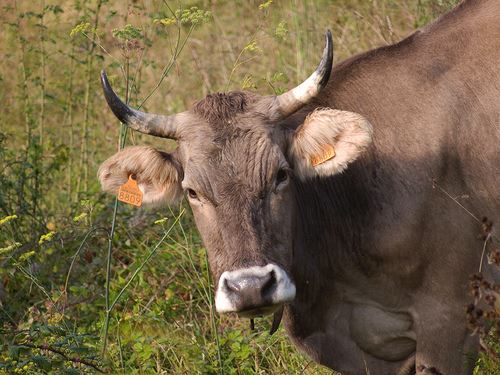
"La vaca: reina de Cantabria (Cerca de Piedras Lenguas 20-09-2009)", Cantabria, North of Spain, by Amaldo Gutiérrez, at flickr.com
The presentation of this study took place in the auditorium of the CITA and has benefited from the intervention of Miguel Angel Garcia Muro, Director of Research and Innovation, together with José Vicente Lacasa, managing director of CITA. Also present M ª Teresa Galvez, director of the ARAID Foundation; Isabel Vasquez, head of Coordination of INIA; Jose Manuel Macarulla, Executive Manager of ARAPARDA and Luis Lascorz, president of ASAPI. The event was attended by farmers, researchers, representatives of agribusiness, and institutional sector.
The study has identified a new gene variant in cattle breeds and Pyrenean Mountain Parda gene Calpastatin (CAST). This gene is involved in the tenderization of the meat. This new variant gene produces an amino acid change in the protein which increases the hardness of the meat. Specifically, the new animals carrying homozygous gene variant have a 22% meat harder than the other genotypes. The application of this new gene variant as a method of predicting meat tenderness in cattle is in the process of registration.
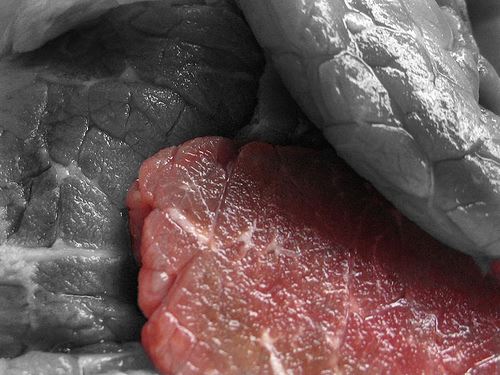
"Carne", by El Instante de soledad, at flickr.com
In his speech, the Director General of Research and Innovation Miguel Angel Garcia Muro stressed "the importance of the food industry as an important driver of our Community" and recalled "the importance that research in this industry." Meanwhile, CITA director José Vicente Lacasa has affected "in the strength of the joint collaboration between public institutions and the private sector," as well as "how important is the relationship between research and the productive, in this case Aragonese livestock
Outstanding Potential applications of this research include the elimination of the gene variant that increases the hardness of the flesh of animals selected for reproduction and inclusion in the catalogs of sires of genotype for these genes, increasing its value and making selection marker-assisted (MAS) for certain lines of animals. Also the certification of a meat or meat product more tender, coming from animals that have no associated genotype hardness.
The effect of this new gene variant found in breeds and Pyrenean Mountain Parda but bioinformatic studies of the sequences deposited in the databases of genes (GeneBank), show that this new mutation exists in cattle breeds distributed throughout the world. This indicates that the use of the application of this new gene variant may be extended to many countries.
Consumers looking to beef meat consistently high quality, considering the most important attributes their nutritional, health, technological quality (color, texture ...) and sensory characteristics (tenderness, flavor, juiciness, color, etc..). These characters are influenced by multiple factors that interact well: driving, race, genotype, feeding, management and stunned before slaughter, slaughter method, method of cooling and conservation. Although customer satisfaction is based on the combination of palatability-flavor, juiciness and tenderness-the emphasis on international research is on this last feature, because it is perceived as more relevant.
Since 2003 CITA develop in the various research linking different feeding patterns and management with meat quality parameters, most notably those of meat tenderness. Thus, the study was conducted in a population of animals under different feeding and management systems, belonging to DNA and tissue bank of CITA and with the financial support of the Government of Aragon and Agricultural Technologies and Resources Program (RTA ) and Permanent Genetic Resources (RZP), both of INIA and with the support of associations and ASAPI ARAPARDA.
I hope this discovery encourage Spanish researchers to continue studying new possibilities in the quality of our lives.
Till soon, kind regards,
Luis.
Sponsored by Costaluz Lawyers.
Please, click down here:
.jpg)
 0
Like
Published at 1:02 PM Comments (0)
0
Like
Published at 1:02 PM Comments (0)
Origin of human body parts, in Spain
Friday, April 5, 2013
In Spanish, there are some words related with the parts of the human body.
For example, “Muscle” comes from “Mouse” –or better: “Little mouse”. “Musculo” is formed with the two words: “Mus” that means “Ratón” = “Mouse” and “Culus” that means “Little”. It started to name the top of a leg; but, after it was used for the rest of the body and the top of the leg was named “Muslo”.
By other side, the word “Pulmón” = “Lung” comes from the latin word ,“Pulmo” and this one comes from the greek word, “Pneumo”, that has to do with the word “Neumo2, that means air or blow and, from it, comes “Neumatico” (of a wheel) = Tire –because it is full of air--.And also from it comes the Pneumonia disease.
Another word “Pupila” = “Pupilos”, that was de diminutive of “Pupus” –that means “Child”--.Then, Pupilos means “Little child” or even “Little doll”.
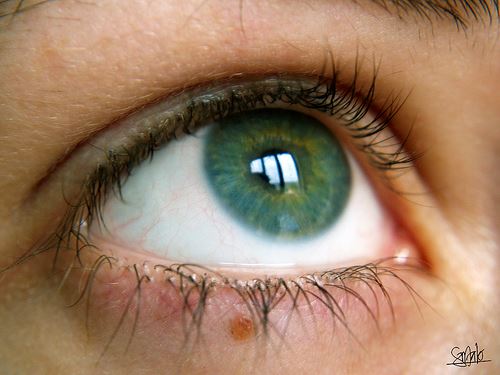
"Ojo Eva" by chalo84, at flickr.com
There are two other words, that means the same thing: Encéfalo and Cerebro. “Encéfalo” comes from the Greek and it is what is inside of a head. And Brain is which leads into the skull.
There are also some words related between them; the y are: Psycology and others, that come from “Psiqué”, that in Greek meant: “Mariposa” = “Butterfly”. It was a metaphor, because greek people thought that Soul was as a butterfly. They thought that when the died, the body was separated from the soul and then, the soul was flying around like a butterfly.
Also, the word “Clavícula” = “Clavicle” means: little key, because it has that form.
I hope that you have liked it, as I have.
Till soon, kind regards,
Luis.
Sponsored by Costaluz Lawyers.
Please click down here:
.jpg)
 0
Like
Published at 8:20 PM Comments (0)
0
Like
Published at 8:20 PM Comments (0)
Cheap houses, in Spain
Friday, April 5, 2013
They started in the 90s, just in the midst the Real Estate Boom, in Spain. Now, in the “Ensanche de Vallecas” (“Widening of Vallecas” ), Madrid, live 100.000 persons, in 28.000 houses. Half of the houses are protected, housing design.

"Ensanche de Vallecas", Madrid, Spain, by besos y flores, at flickr.com
There are a lot of buildings, all different, with different colors.The people who live there pay a few rent –around 200 or 300 Euros or perhaps less--.
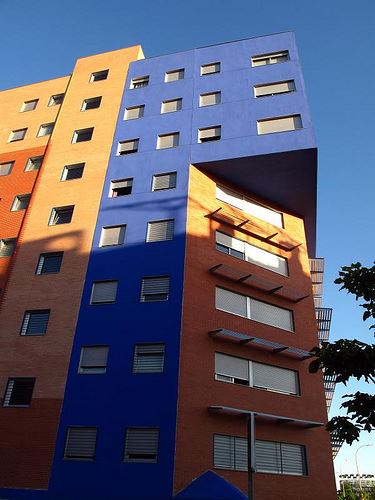
"@Ensanche de Vallecas", Madrid, Spain, by inthesitymad, at flickr.com
But some of those houses are brought.The owners pay about 100.000 Euros.
One of the buildings is very original, because it is metal siding, on its facade.
One of the conditios to buy a flat of those is to have about 600 or 700 Euros, each month, at least.
One of the buildings is everything with green color.It is a famous building even out of Spain, through some magazines of Architecture.
Another way to get a house with protection is through Caritas.This ONG has some houses from inheritances or from donations.Caritas rent this houses on 100, 150, 200 Euros, per month, for poor people.Even many families do not pay anything.
Some weeks ago, it was held an auction of social housing and 9500 people showed up to 30 homes.
There are homes from developers who could not pay the banks and the banks have given them as social housing.
In Barcelona there are also 7000 social housing.
In Madrid there is a colony built in the 50s, by the IVIMA (Institute of Housing in Madrid), named “San Cristóbal”, for workers of the Municipal Transport.There were built 800 houses.
In Madrid there is also another area, named "Pegaso city", where, in the 50s there were built a lot of houses for workers of the Company PEGASO (a company of buses.There were 1500 houses, built among 1956 and 1958.
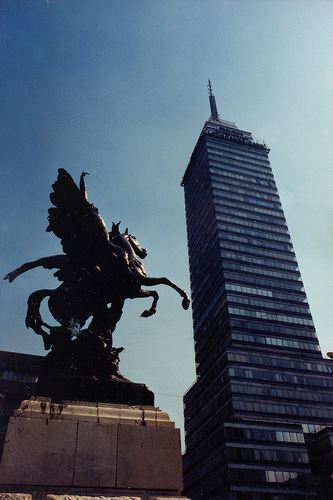
"Pegaso Latino", Madrid, Spain, by Júbilo- haku, at flickr.com
(This horse was the company Anagram).
Till soon, kind regards,
Luis.
Sponsored by Costaluz Lawyers.
Please click down here:
.jpg)
 0
Like
Published at 1:18 AM Comments (0)
0
Like
Published at 1:18 AM Comments (0)
The challenge of learning in Spain
Wednesday, April 3, 2013
Probably you know someone who has Down syndrome.Of course, I do not know its capacity, but surely you do.
Well, but in Spain lives Pablo Pineda, the first person, in Europe, who has finished a University Degree. He has studied Magisterium and now he is starting Psyco-Pedagogy.
.jpg)
Pablo Pineda
Pablo has just published a book tittled “El reto de aprender” (“The challenge of learning”).In it, he says that everybody has any disability; he explain that whe somebody has a disability also has a ability. He ask: “Who hasa total ability?”.Of course, nobody is perfect: so, he is on right when he says that everybody has any disability.
Pablo also says that teachers, in School, should must to show the abilities of a student, not its disabilities.
Pablo says that another important thing is to have friends.He says that in his job, he had companions but he had no friend.
I think this case is a hope for many people with special needs.
Congratulations !.
Till soon, kind regards,
Luis.
Please click down here:
.jpg)
 0
Like
Published at 1:19 AM Comments (0)
0
Like
Published at 1:19 AM Comments (0)
Talking about Money in Spain
Tuesday, April 2, 2013
First of all, we can talk about the expression: “De la Zeca a la Meca”.”Zeca” comes from the word “Sica”, that means: “House of Coin”, where coins are made.
And Meca is a holy place, as the Vatican.
In Spain, we use this expression, when we mean that somebody is doing many things or going to many places –in order to buy or to carry on some things…--.
Another word so used is: “Guita”.It is the string that you put around a bag (to tie a bag) for money.It is used in America and this expression has come to Spain many years ago.
Another word that means money is: “Plata”.It also comes from America, because there, many years ago, they did not use coins, but they weighed metals, as money.Then, as there was a lot of silver, they used that metal as coins.Therefore, the area around the silver river is named so:”Silver river”, because there was a lot of silver in that area.
Another word used as money, is: “Lana”.It is so used in Mexico.An explanation is that there was a lot of wool in Castilla (middle of Spain), where this material was much appreciated; then, in times of conquer it should be very appreciated, as sign of wealth.Then, to have wool should be to have an important economic power.
In America is also used: “Mosca” (Fly) and “Vaca” (Cow).But they have not come to Spain –or, at least, I have never listened them--.
Also, the word: “Pecunia” comes from the Latin word: Pecus, that means “Cattle” –it was used as way to pay, with cows, for example--.And, from “Pecunia”, comes the word, so used in Spain, “Peculiar”, that means it is own of a person --you know a person through its cattle, for example--.
Another word used in Spain, is: “Parné”; it is a word comes from the Spanish language “Caló”, used by a limited community in Spain (the Gypsy community).
The most known word, “Moneda”, comes from the Latin word “Moneta”, that was the nickname for the god “Juno”, in Rome.It is said that in Juno´s temples were made the coins, therefore, money was named “Moneta”, as Juno.You can see that “Money” is similar than “Moneda”.
Another expression used in Spain is: “4 perras”(“Four dogs”).It means that something cost few money, because, in the past, there were two type of coins, of 5 and 10 cents, that had a lyon on their face; but people though that the image was a femail dog instead of a lyon; therefore, tose coins were named “Perra gorda” (fat dog) and “Perra chica” (Little dog).
Another word for meoney is: “Peso”.This coin is used in eight countries of America and in Philippines; but this name comes from Spain, because here there was a monetary reform, in 1497, when was created a piece of “Real de 8” or “Duro””.Also, “Peseta” comes from “Peso”.

"Dinero, dinero, dinero", byGerard:, at flickr.com
Another expression used in Spain, is: “Estar sin blanca” (“To be without white”) . “Blanca” (“White” feminine) was a coin used among the centuries XIV and XVII, in Spain.IAt the beginning, it was a coin made with silver, but with time it became to have less power, less value (with a mix among solver and cooper).
Probably you know some other words, even in English.
Till soon,
Kind regards,
Luis.
Sponsored by Costaluz Lawyers.
Please click down here:
.jpg)
 0
Like
Published at 1:17 AM Comments (0)
0
Like
Published at 1:17 AM Comments (0)
Spam post or Abuse? Please let us know
|
|